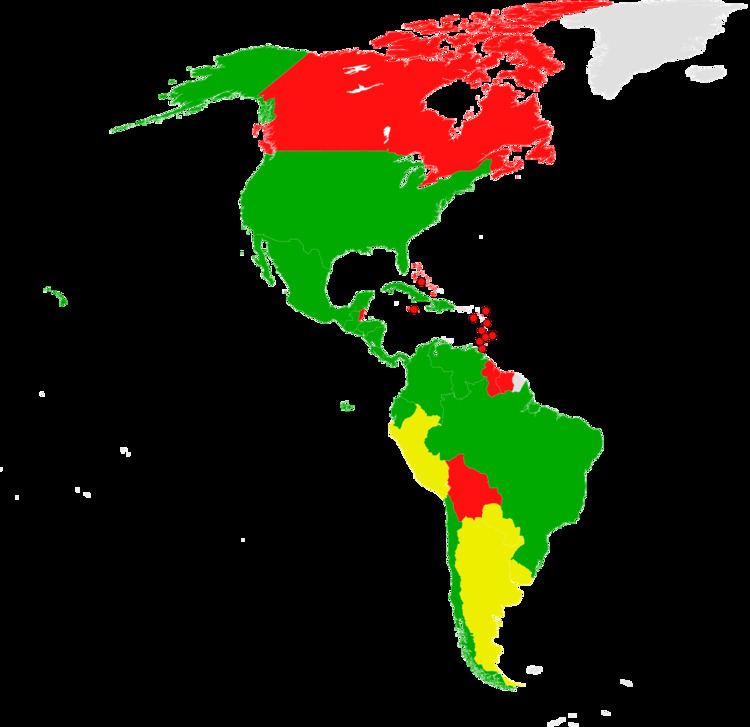Signed December 26, 1933 Effective December 26, 1934 Parties 16 (as of May 2015) | Signatories 20 Depositary Pan American Union | |
 | ||
The Montevideo Convention on the Rights and Duties of States is a treaty signed at Montevideo, Uruguay, on December 26, 1933, during the Seventh International Conference of American States. The Convention codifies the declarative theory of statehood as accepted as part of customary international law. At the conference, United States President Franklin D. Roosevelt and Secretary of State Cordell Hull declared the Good Neighbor Policy, which opposed U.S. armed intervention in inter-American affairs. The convention was signed by 19 states. The acceptance of three of the signatories was subject to minor reservations. Those states were Brazil, Peru and the United States.
Contents
The convention became operative on December 26, 1934. It was registered in League of Nations Treaty Series on January 8, 1936.
Background
The convention sets out the definition, rights and duties of statehood. Most well-known is article 1, which sets out the four criteria for statehood that have been recognized by international organizations as an accurate statement of customary international law:
The state as a person of international law should possess the following qualifications: (a) a permanent population; (b) a defined territory; (c) government; and (d) capacity to enter into relations with the other states.Furthermore, the first sentence of article 3 explicitly states that "The political existence of the state is independent of recognition by the other states." This is known as the declarative theory of statehood.
A basic point should be emphasized: Article 1 is qualified by Article 11 because it prohibits using military force to gain recognition of sovereignty. Furthermore, Article 11 reflects the contemporary Stimson Doctrine, and is now a fundamental part of international law through article 2 paragraph 4 of the Charter of the United Nations.
Some have questioned whether these criteria are sufficient, as they allow less-recognized entities like the Republic of China (Taiwan) to claim full status as states. According to the alternative constitutive theory of statehood, a state exists only insofar as it is recognized by other states. It should not be confused with the Estrada doctrine.
The conference is also notable in American history because one of the U.S. representatives was social worker and educator Dr. Sophonisba Preston Breckinridge (1866-1948). She was the first U.S. female representative at an international conference.
Criticisms
In most cases, the only avenue open to self-determination for colonial or national ethnic minority populations was to achieve international legal personality as a nation-state. The majority of delegations at the International Conference of American States represented independent States that had emerged from former colonies. In most cases, their own existence and independence had been disputed, or opposed, by one or more of the European colonial empires. They agreed among themselves to criteria that made it easier for other dependent states with limited sovereignty to gain international recognition. "Independence" and "sovereignty" are not mentioned in article 1 of the convention.
Parties
The 16 states that have ratified this convention are limited to the Americas.
A further four states signed the Convention on 26 December 1933, but have not ratified it.
The only state to attend the Seventh International Conference of American States, where the convention was agreed upon, which did not sign it was Bolivia. Costa Rica, which did not attend the conference, later signed the convention.
Customary international law
As a restatement of customary international law, the Montevideo Convention merely codified existing legal norms and its principles and therefore does not apply merely to the signatories, but to all subjects of international law as a whole.
The European Union, in the principal statement of its Badinter Committee, follows the Montevideo Convention in its definition of a state: by having a territory, a population, and a political authority. The committee also found that the existence of states was a question of fact, while the recognition by other states was purely declaratory and not a determinative factor of statehood.
Switzerland, although not a member of the European Union, adheres to the same principle, stating that "neither a political unit needs to be recognized to become a state, nor does a state have the obligation to recognize another one. At the same time, neither recognition is enough to create a state, nor does its absence abolish it."
